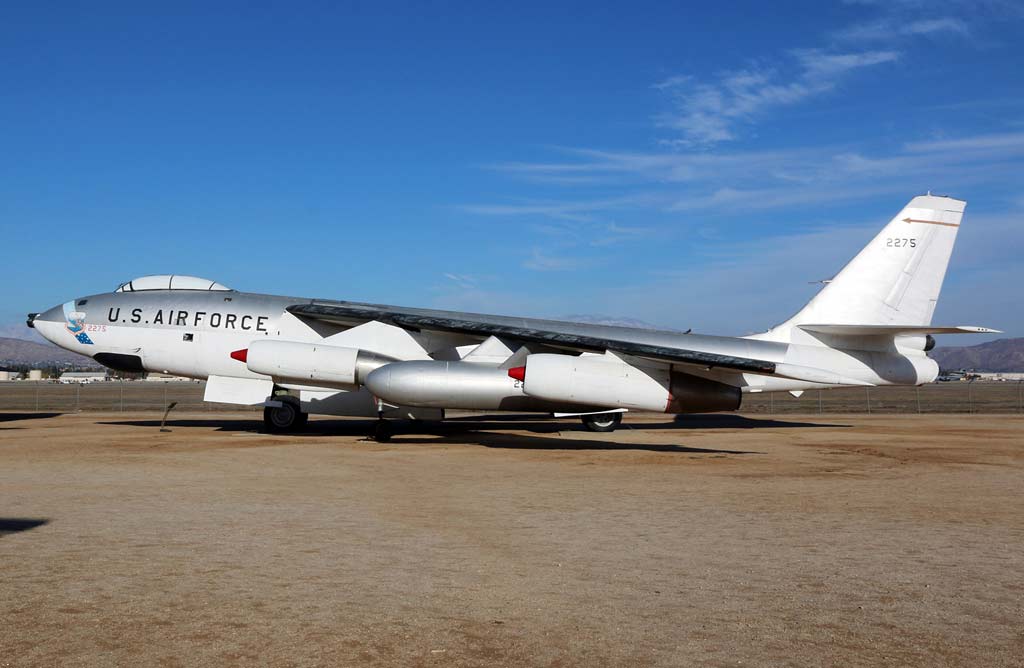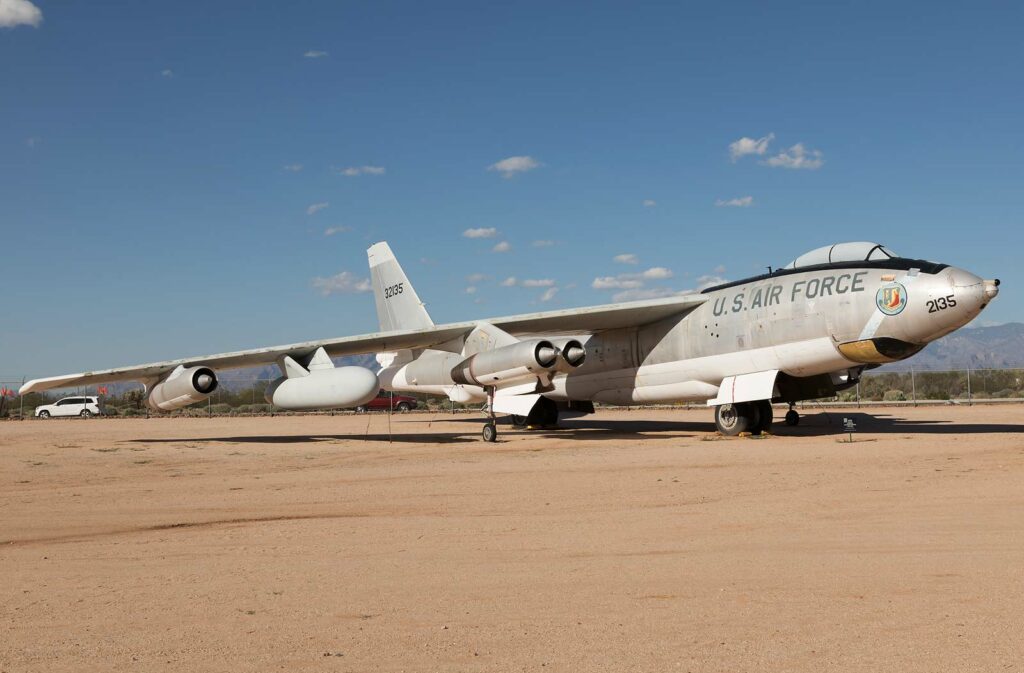The Boeing B-47 Stratojet was a long-range, six-engine, turbojet-powered strategic bomber capable of carrying nuclear weapons.
In brief
The Boeing B-47 Stratojet, a cornerstone of the United States Air Force’s Strategic Air Command throughout the 1950s and into the 1960s, was the first mass-produced jet-powered bomber. It was designed to carry nuclear weapons and represented a significant leap forward in aerodynamics with its swept-wing design, high speed, and operational altitude. Its introduction revolutionized air strategies and became a critical component of the U.S. nuclear deterrence policy during the Cold War. The B-47 broke various flight performance records and served as a platform for various technological advancements in aviation.
The Boeing B-47 Stratojet holds a prominent place in aviation history as the first swept-wing multi-engine bomber. It played a crucial role in transitioning bombing strategies from high altitude, propeller-driven aircraft to high-speed, jet-powered ones.

History of the Development of the Boeing B-47 Stratojet
The development of the Boeing B-47 Stratojet was a response to the needs of the Cold War era, requiring a fast, high-altitude, long-range bomber capable of delivering nuclear weapons. The United States Air Force, recognizing the need for strategic deterrence against the Soviet Union, initiated the program. Boeing, along with other major aircraft manufacturers, competed in the design proposal, with Boeing’s Model 450 winning due to its innovative swept-wing design and promise of superior performance.
The B-47 program was launched in the late 1940s, with the first prototype flying on December 17, 1947. The design and development of the B-47 coincided with significant advancements in aeronautical engineering, including the incorporation of jet propulsion and aerodynamic enhancements. The aircraft did not receive a specific NATO nickname as it was predominantly an American strategic asset.
The development of the B-47 was also driven by the strategic necessities of nuclear warfare, where speed, range, and payload capacity were paramount. It was part of the United States’ strategy to maintain air superiority and a credible nuclear deterrent, reflecting the broader military and geopolitical context of the post-World War II era.
Design of the Boeing B-47 Stratojet
The Boeing B-47 Stratojet was revolutionary in its design, featuring a swept-wing configuration, which significantly reduced aerodynamic drag at high speeds. This design was influenced by German research and further developed by American engineers. The aircraft had a length of 107 ft (32.6 m) and a wingspan of 116 ft (35.4 m). It was powered by six General Electric J47 turbojet engines, mounted in pods under the wings.
One of the notable design elements of the B-47 was its bicycle-type landing gear, with two main landing gears in the fuselage and smaller stabilizing gear in the engine pods. This arrangement was necessary due to the thin wing design. While this design provided speed and range advantages, it also posed challenges, particularly in crosswind landings and maneuverability on the ground.
The B-47’s design brought significant advancements in aerodynamics, jet propulsion, and aircraft control systems, setting new standards for speed, altitude, and range that influenced future aircraft designs. However, its operational complexity and maintenance requirements were notable drawbacks, reflecting the trade-offs of early jet-powered aircraft.
Performance of the Boeing B-47 Stratojet
The performance of the Boeing B-47 Stratojet was a marked improvement over previous bombers. It could reach speeds of up to 607 mph (977 km/h) and had a service ceiling of 33,100 ft (10,090 m). The aircraft had a range of about 3,850 miles (6,200 km) without aerial refueling. With aerial refueling, it could essentially complete intercontinental missions, a critical requirement for strategic deterrence.
Compared to its contemporaries, the B-47 was a superior strategic bomber in terms of speed, altitude, and range. Its ability to carry a significant payload of nuclear weapons and perform high-speed, high-altitude missions made it a formidable platform during its time. However, as aircraft technology rapidly advanced, later bombers and missile systems began to overshadow the B-47’s capabilities.
Variants of the Boeing B-47 Stratojet
The Boeing B-47 Stratojet had several variants, each designed for different roles or with different technological enhancements. The primary production models were the B-47B and B-47E. The B-47B was the initial production model, while the B-47E featured more advanced engines, increased fuel capacity, and improved avionics. There were also reconnaissance versions, including the RB-47, equipped with cameras and sensors for intelligence gathering.

Military Use and Combat of the Boeing B-47 Stratojet
The B-47 never engaged in direct combat but was a central element of America’s strategic nuclear deterrent during the Cold War. It was primarily used for high-altitude, long-range bombing missions and reconnaissance operations. The Stratojet’s primary role was to serve as a platform for nuclear weapon delivery, making it a key part of the United States’ strategy of deterrence.
The aircraft also played a significant role in various military exercises and operations, simulating nuclear bombing runs and providing a continuous airborne alert. While the B-47 was never sold to other countries due to its strategic nature, it played a crucial role in NATO and U.S. defense strategies. Its deployment across various bases in the U.S. and Europe was a testament to its strategic importance.
The B-47 was eventually phased out in the 1960s as more advanced bombers, such as the B-52 Stratofortress, took over its role. The advancements in ICBM technology also diminished the strategic need for manned long-range bombers.
The Boeing B-47 Stratojet was a landmark aircraft in the history of military aviation. As the world’s first large, multi-engine jet bomber, it set new standards for speed, altitude, and range, significantly influencing strategic bombing strategies and the development of future aircraft. The B-47 epitomized the technological and strategic advancements of the early Cold War era, representing a leap forward in aeronautics that shaped the future of military aviation. While it never saw combat, its role in nuclear deterrence and strategic reconnaissance was invaluable, making it a key asset in maintaining global peace and stability during a tense period of human history.
Back to the Bombers section.